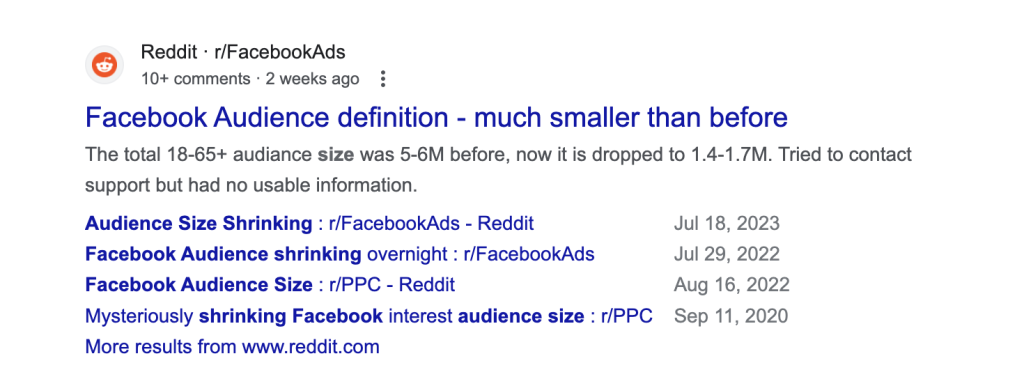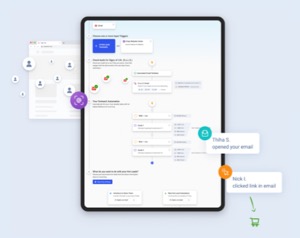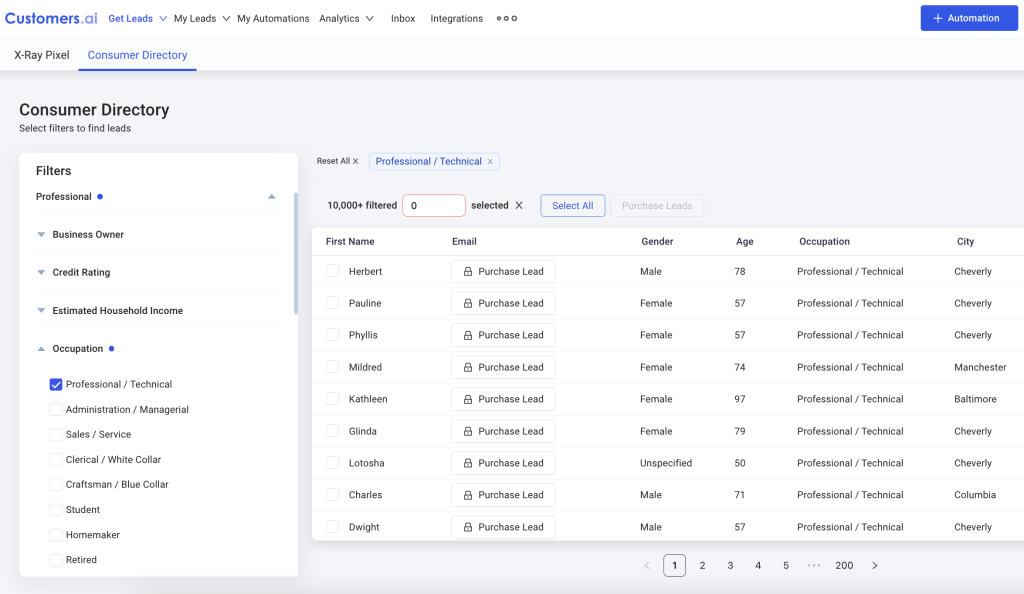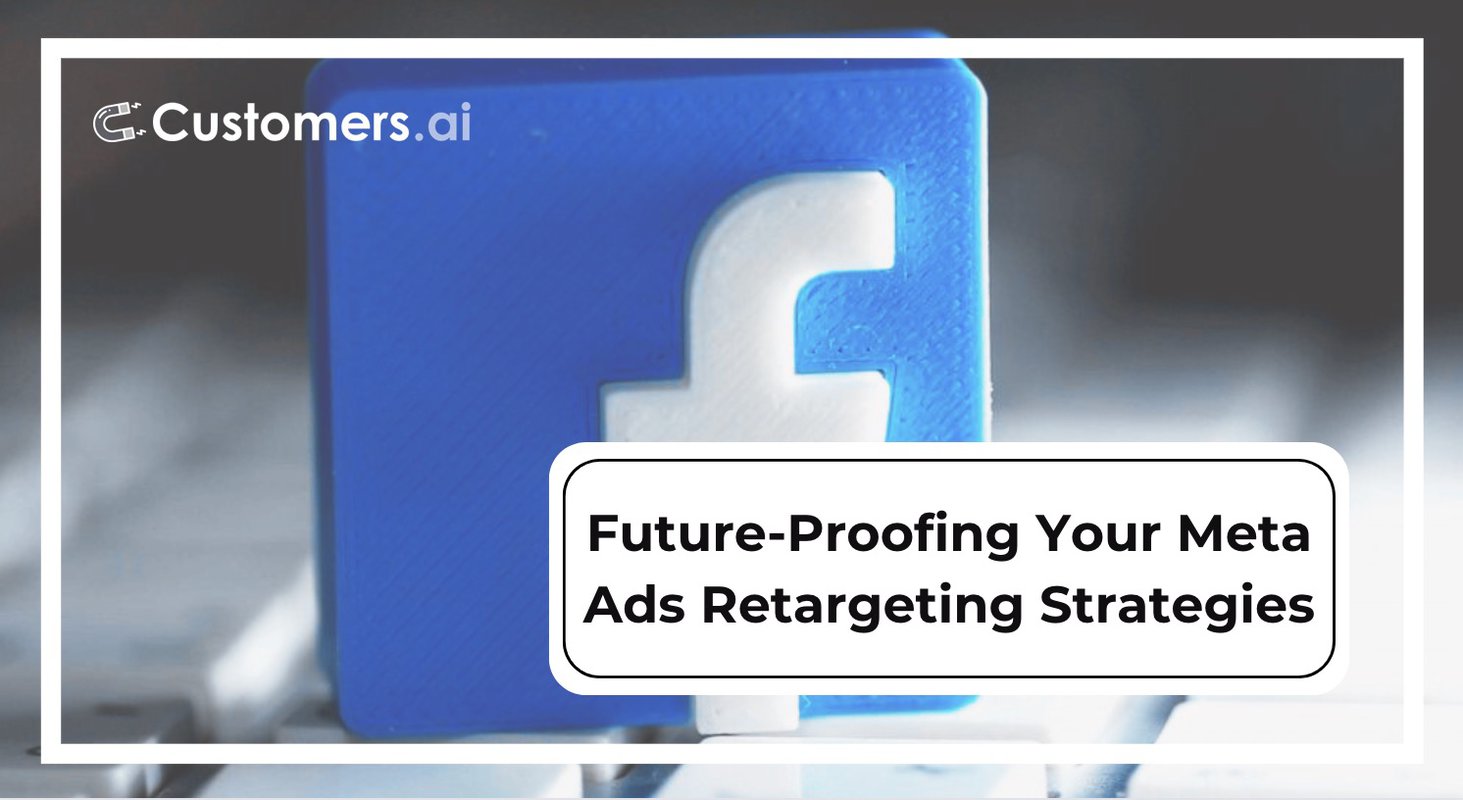For years, Meta Ads have been a mainstay in digital marketing strategies, with companies predicted to spend between $36.5 billion and $40 billion in Q4 2023 alone.
However, the landscape is undergoing a seismic shift, with the repercussions of privacy changes reverberating across the advertising sphere. The recent implementation of iOS 17 changes and the impending removal of third-party cookies in Google Chrome in 2024 are casting shadows on the once-expansive reach of Meta Ads.
Unfortunately for marketers, this isn’t a future problem. Meta Ads retargeting audiences are already shrinking!

There is an urgent need for strategic solutions to navigate the shrinking terrain of Meta Ads retargeting audiences. With more privacy changes likely on the way and cross-channel tracking already becoming more difficult, the time for action is now.
- Why Are Meta Ads Retargeting Audiences Shrinking?
- Strategies to Grow Your Meta Ads Retargeting Lists
- Future-Proofing Your Meta Ads Retargeting Strategies
- Meta Ads Retargeting Audience FAQs

See Who Is On Your Site Right Now!
Turn anonymous visitors into genuine contacts.
Try it Free, No Credit Card Required
Why Are Meta Ads Retargeting Audiences Shrinking?
The shrinking of Meta Ads retargeting audiences can be attributed to a confluence of factors, each contributing to the challenging terrain businesses now navigate:
- iOS 14 Changes: The introduction of iOS 14 brought forth an era of heightened user privacy on Apple devices. With App Tracking Transparency (ATT), users gained control over whether apps, including those running Meta Ads, could track their activity across other apps and websites. With only 34% of users now opted-in and allowing tracking, this was and continues to be a major factor in shrinking remarketing audiences.
- Link Tracking Protection in iOS 17: The subsequent iOS 17 changes extended privacy measures, introducing Link Tracking Protection. This feature not only obstructs the conventional tracking of link clicks but also imposes limitations on the effectiveness of retargeting strategies, as it hampers the gathering of crucial user interaction data.
- Meta’s Evolving Targeting Options: Meta’s continuous removal of targeting options compounds the challenge. As privacy concerns grow, Meta has been compelled to adjust its targeting features, restricting the precision with which advertisers can reach their desired audience. A thorn in the side of marketers, this ongoing reduction of targeting options shrinks our list sizes and disrupts our once finely-tuned retargeting strategies.
The reality is that between iOS updates and Meta’s targeting adjustments, advertisers face a discernible reduction in retargeting audience size.

See Who Is On Your Site Right Now!
Turn anonymous visitors into genuine contacts.
Try it Free, No Credit Card Required
Adapting to Privacy Changes: Strategies to Grow Your Meta Ads Retargeting Lists
In the face of evolving privacy changes, businesses can proactively adapt and cultivate resilient retargeting lists through a multifaceted approach. These include:
1. Emphasize First-Party Data Collection
As tech companies continue to take away third-party data, prioritizing the development of robust first-party data sources is a must. Here are a few tips on how to collect first-party data:
- Compelling Lead Magnets: Create irresistible incentives that encourage users to willingly share their information. This could be in the form of exclusive content, discounts, or access to premium features. Tailor these lead magnets to align with your audience’s interests, ensuring a higher likelihood of opt-ins.
- Strategic Pop-Ups and Opt-In Forms: Implement strategic pop-ups and opt-in forms on your website. Ensure these are strategically timed and unobtrusive, providing visitors with a seamless experience and giving you the first-party data you need. Make sure to clearly communicate the value proposition of subscribing or sharing their information.
- Offer Personalized User Accounts: Encourage users to create personalized accounts on your platform. Highlight the benefits of an account, such as saved preferences, personalized recommendations, or exclusive access. This not only fosters a sense of belonging but also provides a direct channel for collecting user data with their consent.
- Interactive Content and Gamification: Engage users with interactive content and gamification elements to make the data collection process feel natural. Quizzes, polls, and games not only capture attention but also encourage participation. Incorporate data collection fields seamlessly within these interactive elements, turning the process into a more interactive and entertaining experience for users.
- Utilize Website Visitor ID Tools: Website visitor identification tools like Customers.ai can help you capture user data, giving you access to names, emails, and even LinkedIn profiles of your site visitors. Most importantly, they give you YOUR data. That data can then be turned into retargeting campaigns, email campaigns, lead nurturing, and so much more.
The great thing is, you can install Customers.ai in under 90 seconds!
To install the Website Visitor ID X-Ray Pixel, sign up (for FREE!), go to your dashboard, and navigate to My Automations.
Select + New Automation and get your pixel. We have easy install options for Google Tag Manager, WordPress, and Shopify, or you can install the pixel manually.

Implementing the Website Visitor ID X-ray pixel along with these tips ensures that your first-party data collection efforts are not only effective but also align with ethical principles and user preferences, fostering a positive relationship between your brand and your audience.
2. Nurture Customer Relationships
Shifting the focus from one-off transactions to building sustained relationships is pivotal in the post-privacy-change era.
Beyond mere transactions, fostering genuine connections is the key to not only retaining customers but also leveraging them as advocates who organically contribute to the expansion of your Meta Ads retargeting lists.
Here are three tips for effective customer nurturing campaigns:
- Personalized Communication: Tailor your communication to individual preferences, ensuring that each interaction feels personalized and relevant. Utilize customer data to understand their preferences, purchase history, and engagement patterns. Craft targeted messages that speak directly to their needs and interests, fostering a sense of connection and understanding.
- Exclusive Offers: Incentivize loyalty by providing exclusive offers and rewards to your existing customers. This could include early access to sales, special discounts, or loyalty programs. By making your customers feel valued and appreciated, you not only strengthen their loyalty but also create a positive association that encourages them to continue engaging with your brand.
- Consistent Engagement: Maintain a consistent and meaningful presence in your customers’ lives. Regularly communicate through various channels, including email, social media, and SMSt. Share relevant updates, industry insights, or exclusive behind-the-scenes content. Consistent engagement keeps your brand top-of-mind and reinforces the connection with your audience.
As satisfied customers become advocates, they amplify your brand’s reach through their networks, creating a ripple effect that extends the impact of your retargeting efforts.
3. Add Dynamic Retargeting to the Mix
Dynamic retargeting is a sophisticated advertising strategy that tailors ad content to individual users based on their previous interactions with a website or app. It utilizes real-time data to showcase products or services that users have previously shown interest in, creating highly personalized and relevant advertisements.
As users browse the internet, dynamic retargeting ensures that they encounter tailored ads across various platforms, reinforcing brand awareness and encouraging them to revisit the site.
How does that help grow Meta Ads remarketing lists? It helps in two main ways:
- Relevance and Personalization: By delivering ads that align with users’ past interactions, dynamic retargeting enhances the relevance of your ads. This heightened relevance not only captures users’ attention but also increases the likelihood of them revisiting your website, thus growing your retargeting lists organically.
- Persistent Brand Presence: Dynamic retargeting ensures a persistent brand presence across users’ online journeys. Even within the constraints of privacy changes, the personalized nature of these ads fosters a sense of familiarity and connection. This consistency contributes to the overall effectiveness of your retargeting efforts.
Convert Website Visitors into Real Contacts!
Identify who is visiting your site with name, email and more. Get 500 contacts for free!
4. Build Lookalike Audiences from Customer Data
Lookalike audiences have a number of benefits when it comes to growing your remarketing list and improving overall Meta Ads performance. These include:
- Increased Precision: Lookalike audiences enhance the precision of your targeting efforts by identifying and reaching users who exhibit characteristics similar to your existing customer base.
- Expanded Reach: By extending your reach to users who share traits with your established audience, you tap into a larger pool of potential customers who are more likely to be receptive to your Meta Ads retargeting campaigns.
- Optimized Ad Spend: Targeting lookalike audiences optimizes your ad spend by directing resources toward individuals who are more likely to engage with your content and convert.
By strategically building lookalike audiences from existing customer data, you can unlock the potential for substantial growth in your Meta Ads retargeting lists. Here’s how:
- Leverage Anonymous Visitor Data from Customers.ai: If you have the Website Visitor ID X-Ray pixel installed, you are already capturing visitors to your site. By understanding the characteristics of users who have engaged with your content, you can identify key attributes that define their target audience. This anonymized data serves as a foundation for building lookalike audiences that share similar traits and preferences and helps grow your retargeting lists.
- Leverage CRM Data: Your CRM system holds a wealth of information about your existing customer base. Analyze this data to identify key demographics, behaviors, and preferences exhibited by your most valuable customers. By extracting insights from CRM data, you can build lookalike audiences that mirror the characteristics of your high-converting customers.
- Use Existing Remarketing Audiences: Your existing remarketing audiences represent individuals who have already demonstrated interest in your products or services. By leveraging the data from these audiences, you can create lookalike audiences that share commonalities with your most engaged and responsive users, extending the reach of your retargeting efforts to a broader yet relevant pool of potential customers.
5. Fill the Top of Your Funnel Manually
We all want to grow our audience organically but as the saying goes, we don’t always get what we want. It’s why list buying is a common practice, especially when it comes to outbound marketing.
Unfortunately, while buying leads can be a common practice, ensuring the quality and alignment with your ICP is more complicated.
Typical list-buying companies can’t always deliver who you want, leading to wasted spend.
The Customers.ai intent-based consumer directory gives you 10,000 in-market and interest-based targeting signals across 250 million U.S. consumers, allowing you to fill the top of your funnel with precision.

By sorting and filtering based on your specific criteria, you can pinpoint individuals who genuinely align with your target audience, laying a solid foundation for a robust Meta Ads retargeting strategy and growing your lists.
Looking Forward: Future-Proofing Your Meta Ads Retargeting Strategies
Future-proofing your Meta Ads retargeting strategies will only become more important as tech companies continue to focus on privacy. Anticipating the impact of regulations and staying ahead of innovations is key to sustained success.
Predictions certainly suggest more stringent regulations on user data tracking, forcing marketers to brace for an environment where user consent and data protection take center stage. Staying informed and agile in adapting to evolving privacy standards will be crucial for maintaining effective retargeting strategies.
How to Future-Proof Your Retargeting Efforts
Nothing in life is guaranteed but we can certainly give ourselves the best chance at success. Along with the strategies we touched on above, there are two other ways we can future-proof our retargeting efforts:
- Focus on First-Party Data: We said it earlier but the more data you own, the more successful your retargeting efforts will be. Get creative in capturing visitor data but don’t be obnoxious. Not every customer wants to be emailed or messaged. It’s why retargeting is such a great solution. It’s a way to touch potential customers without being pushy.
- Embrace Ethical Data Practices: Prioritize ethical data collection and usage to build trust with your audience. Transparent communication about data policies ensures compliance with evolving regulations and fosters positive relationships with users.
- Diversify Retargeting Channels: While we have been talking about Meta Ads, it is important to reduce dependency on a single platform. By diversifying retargeting efforts across various channels, we can hedge against the impact of specific platform changes and give ourselves a broader audience reach.
Know What’s Next
Keeping an eye on innovations within Meta Ads and the broader digital advertising landscape is essential for staying competitive. A few things that stand out to us:
- Advanced AI and Machine Learning: We are an AI company and we know AI is not just the future, but it’s already here. Advancements in AI and machine learning algorithms within Meta Ads will hopefully enable more sophisticated retargeting strategies. Utilize these tools to automate and optimize campaigns for better efficiency.
- Interactive and Immersive Ad Formats: Be on the lookout for new ad formats that prioritize interactivity and immersion. Engaging users through innovative formats enhances the user experience, making your retargeting efforts more impactful.
In navigating the future of retargeting, we have to be proactive in adapting to privacy changes and staying abreast of emerging innovations. Adapt or die.
Making Your Retargeting Troubles Disappear
The challenges posed by privacy changes to Meta Ads reach have reshaped the retargeting terrain, demanding strategic adaptation from marketers and advertisers across the board.
To succeed, we not only have to understand why retargeting audiences are shrinking but also identify what we can do about it. From collecting first-party data and utilizing the strategies noted above to future-proofing our campaigns, there is no shortage of must-dos.
Additionally, harnessing the power of tools like Customers.ai will be a game changer for businesses.
Knowing who is on your website opens the door to bigger lists, bigger audiences, better targeting, and faster growth.
Convert Website Visitors into Real Contacts!
Identify who is visiting your site with name, email and more. Get 500 contacts for free!
Important Next Steps
- See what targeted outbound marketing is all about. Capture and engage your first 500 website visitor leads with Customers.ai X-Ray website visitor identification for free.
- Talk and learn about sales outreach automation with other growth enthusiasts. Join Customers.ai Island, our Facebook group of 40K marketers and entrepreneurs who are ready to support you.
- Advance your marketing performance with Sales Outreach School, a free tutorial and training area for sales pros and marketers.
Meta Ads Retargeting Audience FAQs
Q. What is meta ads retargeting?
Meta ads retargeting involves displaying ads to users who have previously interacted with your website or content on platforms within the Meta ecosystem.
Q. How does meta ads retargeting work?
Meta ads retargeting uses cookies to track users’ online behavior, allowing advertisers to show targeted ads to individuals who have visited their website. With the depracation of cookies, companies will need to focus on first-party data.
Q. Why is retargeting important for Meta ads?
Retargeting on Meta is crucial for re-engaging potential customers, increasing brand awareness, and driving conversions by reaching users who have already shown interest.
Q. What are the key benefits of using meta ads for retargeting audiences?
Meta ads for retargeting audiences offer increased ad relevance, higher conversion rates, and cost-effective advertising by focusing on users with existing interest.
Q. How to set up meta ads retargeting campaigns?
To set up meta ads retargeting campaigns, use the Meta Ads Manager to create custom audiences based on website interactions and define ad placements.
Q. What are the best practices for optimizing meta ads retargeting?
Optimize meta ads retargeting by refining audience segments, crafting compelling ad creatives, and testing different ad formats to maximize engagement.
Q. Can you target specific pages with meta ads retargeting?
Yes, you can target specific pages or sections of your website by creating custom audiences based on users’ interactions with those pages.
Q. What types of interactions can be used for retargeting on Meta?
Interactions such as page visits, clicks, and form submissions can be used to create custom audiences for meta ads retargeting.
Q. How long should the retargeting duration be for meta ads?
The retargeting duration for meta ads should align with your sales cycle, but commonly ranges from 30 to 90 days for effective engagement.
Q. What is the relevance score in meta ads retargeting?
The relevance score measures the effectiveness of your Meta Ads by evaluating how well they resonate with the targeted audience. Higher scores often result in better ad performance.
Q. Are there budget considerations for meta ads retargeting campaigns?
Set a budget for your meta ads retargeting campaigns based on your advertising goals, audience size, and desired reach to control costs effectively.
Q. How to exclude certain audiences from meta ads retargeting?
Exclude specific audiences from meta ads retargeting by utilizing exclusion criteria in the Ads Manager when defining your custom audience.
Q. Can meta ads retargeting be used for e-commerce businesses?
Yes, meta ads retargeting is highly effective for e-commerce businesses, helping to re-engage potential customers and drive sales.
Q. What is the role of dynamic ads in meta ads retargeting?
Dynamic ads in meta ads retargeting automatically show users personalized content based on their previous interactions, enhancing relevancy and engagement.
Q. How can I measure the success of meta ads retargeting campaigns?
Measure success by tracking key metrics such as click-through rates, conversion rates, and return on ad spend (ROAS) in the Meta Ads Manager.
Q. What are the common mistakes to avoid in meta ads retargeting?
Avoid common mistakes in meta ads retargeting, such as neglecting to refresh creatives, targeting too broadly, and not analyzing campaign performance regularly.
Q. Is meta ads retargeting effective for B2B marketing?
Yes, meta ads retargeting is effective for B2B marketing, allowing businesses to stay top-of-mind with potential clients and nurture leads through the sales funnel.
Q. Can meta ads retargeting be combined with other advertising strategies?
Yes, combine meta ads retargeting with other strategies like lookalike audiences and interest targeting for a comprehensive and targeted advertising approach.
Q. How often should I update my meta ads retargeting creatives?
Update your meta ads retargeting creatives regularly to maintain audience interest and relevance, preventing ad fatigue.
Q. What role does audience segmentation play in meta ads retargeting?
Audience segmentation in meta ads retargeting allows you to tailor specific messages to different user segments, increasing the effectiveness of your campaigns.
Q. Are there privacy concerns with meta ads retargeting?
Address privacy concerns by ensuring compliance with data protection regulations and being transparent with users about your retargeting practices.
Q. Can I use meta ads retargeting for app installations?
Yes, meta ads retargeting can be employed to promote app installations by targeting users who have visited your app’s website or engaged with related content.
Q. What is the role of frequency capping in meta ads retargeting?
Frequency capping limits the number of times a user sees your ad, preventing ad fatigue and improving the overall user experience in meta ads retargeting.
Q. How can I create compelling ad copy for meta ads retargeting?
Craft compelling ad copy for meta ads retargeting by addressing pain points, highlighting benefits, and using concise language to capture audience attention.
Q. What are the best resources for staying updated on meta ads retargeting trends?
Stay updated on meta ads retargeting trends by following Meta’s official resources, industry blogs, and participating in relevant online communities and forums.
